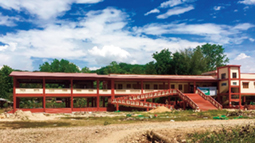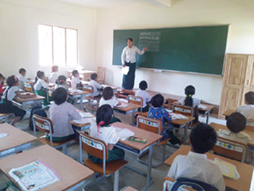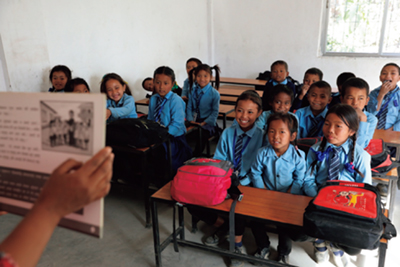(7) Mainstreaming of Disaster Risk Reduction, Measures of Disaster Risk Reduction, and Post-Disaster Recovery and Creating Sustainable Cities
Disasters including earthquakes, tsunamis, typhoons, floods, droughts, and debris flows, that occur frequently around the world do not merely take human lives and property. In developing countries that are vulnerable to disasters, the poor are more likely to be affected significantly and displaced by disasters. In addition, protracted secondary damage such as the deterioration of sanitary conditions and food shortages, can increase the severity of the issue, and have a significant impact on the entire society and economy in developing countries. Therefore, it is necessary to build a disaster-resilient and flexible society to protect human lives from disasters. At the same time, efforts aimed at sustainable development are needed. Among them, it is important to promote the “mainstreaming of disaster risk reduction” that introduces the perspective of disaster risk reduction in all the development policies and plans.
Moreover, in recent years, attention has been focused on the various issues relating to the management of cities, which serve as primary settlement areas of humans and are the focal points of economic, social, and political activities. For example, such issues include measures to handle the disposal of the substantial amount of waste emitted in urban areas and suburbs, prevention of air, water, and other pollution, development of infrastructure facilities including sewage and waste treatment systems, and responses to rapid population increases and the consequent rapid pace of urbanization. Addressing these issues and engaging in efforts to realize sustainable cities have become priorities for development cooperation. Thus, among the SDGs, Goal 11 sets forth the following task: “Make cities and human settlements inclusive, safe, resilient and sustainable.” Likewise, there is growing international interest in resolving the issues of human settlements, including realizing sustainable cities.
Myanmar Public nomination
Enhancing Comprehensive School Safety in Collaboration with Community in Hinthada Township
Grant Assistance for Japanese NGO Projects (March 2018 - (ongoing))
The Nabegon village, located in the Hinthada Township of Myanmar, has been flooded for months in the rainy season when the water level of the neighboring Ayeyarwady River rose. There was no safe shelter from flood waters although the water level could reach as high as two meters, and the old wooden building of the local school, which was easily affected by floods, made it often impossible to continue classes.
In response, SEEDS Asia, a non-profit organization engaged in capacitating people and communities to be more resilient to disasters, constructed a “school-cum-shelter” made with reinforced concrete and equipped with raised floors to ensure continued education opportunities and protection of the village residents during floods. This facility is intended to be used as a center for educational and community activities in normal daily life, and is designed to maintain spaces for conducting classes while accommodating evacuees when a flood hits the village. The facility’s basic concept of ensuring the health and safety of children while being disaster-resilient, as well as serving as a local disaster management hub, derives from the reconstructive primary schools once built in Japan as part of the reconstruction projects following the Great Kanto Earthquake of 1923. Moreover, furniture such as unused desks, chairs, and blackboards donated by Tamba City, Hyogo Prefecture, due to a decline in its population of schoolchildren, is now being used in Nabegon primary school. Volunteers gathered from all over Japan for the cleaning and transportation of the furniture from Tamba, and new relationships between the children of Tamba City and children of Nabegon village were established through the exchange of video letters. Additionally, donations by citizens of Japan and Myanmar enabled the installation of a ramp for easier access by the elderly and children with lower limb disabilities to the facility.
In order to make effective use of this facility, SEEDS Asia set up a village disaster management committee consisting of 41 teachers and local residents. In this fiscal year, capacity building training is being carried out each month targeting Nabegon village as well as its surrounding 12 villages. This training aims at enhancing the disaster response capacity of the villages including with the cooperation of Kyoto Municipal Takakura Elementary School, which has a school management council operated by the community, and introducing good practices and the mechanism of collaborative activities between the school and its community.

The completed school-cum-shelter (Photo: SEEDS Asia)

Children of Nabegon village primary school studying with the school furniture donated by Tamba City in Hyogo Prefecture (Photo: SEEDS Asia)
●Japan’s Efforts
Cooperation in Disaster Risk Reduction

A teacher at an elementary school in Nepal reading aloud a picture story on topics such as evacuation methods during disasters as part of a project through the Grant Assistance for Japanese NGO Projects (Photo: Shanti Volunteer Association)
Japan utilizes its enriched knowledge and technology acquired through its past experiences with natural disasters, such as earthquakes and typhoons, to provide proactive support for disaster risk reduction and post-disaster recovery measures, alongside emergency assistance. In 2015, as a result of the Third UN World Conference on Disaster Risk Reduction held in Sendai City, the Sendai Framework for Disaster Risk Reduction 2015-2030 (Sendai Framework) was adopted. The Sendai Framework incorporated ideas proposed by Japan, such as the “mainstreaming of disaster risk reduction,” the importance of investment in disaster risk reduction, the commitments of diverse stakeholders, the concept of “Build Back Better,” and the importance of women’s leadership.
Furthermore, Prime Minister Abe announced the Sendai Cooperation Initiative for Disaster Risk Reduction Phase 2 in 2019 as a new support initiative that would become Japan’s future basic policy for cooperation in the field of disaster risk reduction. Japan demonstrated its attitude to further contribute to the international community by utilizing its advanced expertise and technology in the field of disaster risk reduction through this announcement. Under this initiative, Japan announced to provide support for at least five million people over the four-year period from 2019 to 2022 through flood countermeasures and other measures that contribute to making the world resilient against disasters so that everyone can live in safety, as well as human resources development for a total of 48,000 officials and local leaders, and disaster risk reduction education for a total of 37,000 children who will create the next generation. Such efforts by Japan enhanced not only the quality of building structures and improvement of disaster monitoring facilities in each country, but also the development of human resources in fields such as laws and plans enactment related to disaster risk reduction, formulation of disaster risk reduction policies, and disaster monitoring. Consequently, the mainstreaming of disaster risk reduction is progressing in each country.
In addition, at the UN summit that adopted the 2030 Agenda in September 2015, Prime Minister Abe encouraged other countries to set the UN’s World Tsunami Awareness Day in order to raise awareness of tsunamis. As a result, a resolution adopted at the UN General Assembly in December the same year, established November 5 as World Tsunami Awareness Day. Accordingly, Japan organized the “High School Students Summit on World Tsunami Awareness Day 2019 in Hokkaido” in Sapporo, on September 2019.
Realizing Sustainable Cities
Based on the Development Cooperation Charter, Japan implements initiatives to resolve global issues directly related to human settlements, including efforts for promoting disaster risk reduction, recovery from natural disasters, and a sound water cycle. In particular, drawing on its know-how and experience, Japan develops infrastructure, including water and sewage, waste, and energy facilities. In addition, Japan carries out disaster risk reduction programs, human resources development, etc. based on the concept of “Build Back Better,” striving to build cities that are more resilient to natural disasters after rebuilding. Furthermore, Japan implements initiatives through providing assistance to the United Nations Human Settlements Programme (UN-Habitat), which promotes sustainable urban development. One example can be seen in Japan’s collaboration with the UN-Habitat Regional Office for Asia and the Pacific (ROAP), based in Fukuoka, to introduce the environmental technology of private-sector companies and local governments in Japan to their overseas counterparts.
Moreover, at the Third UN Conference on Housing and Sustainable Urban Development (HABITAT III) held in Quito, Ecuador in South America in 2016, the New Urban Agenda (NUA) was adopted as a policy for international efforts aimed at the solution of issues pertaining to urban problems and human settlements, based on the results of the efforts that each country has undertaken in the area of human settlement. NUA contributes to the achievement of the SDGs including Goal 11, and Japan is also advancing efforts aimed at the implementation of NUA.
